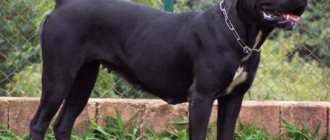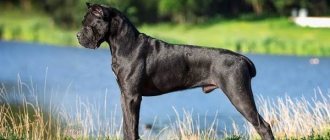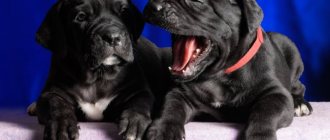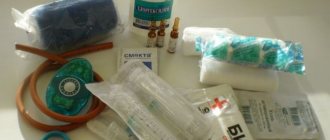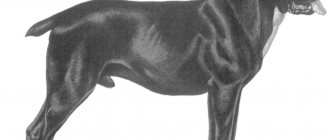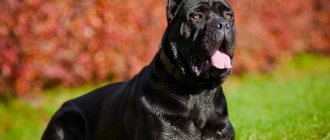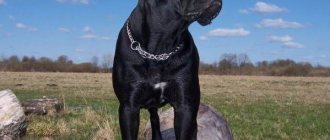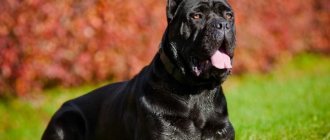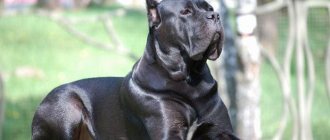If a Cane Corso appears in the house, it must be cared for taking into account the specific characteristics of the animal.
This breed is unpretentious, but this does not mean that its maintenance can be treated negligently.
She is able to live in the courtyard of a private house (street conditions) and in an apartment (home conditions), effectively performing the main task - security and protection.
However, in order for the dog to be healthy and develop normally, certain rules must be followed.
History of the breed
The history of the Cane Corso originates in Ancient Rome from the Molossian dogs.
In different historical eras, these animals were used as fighting dogs, hunters of large animals, but their main purpose was guard functions and protection of all family members, their property, as well as the protection of various institutions.
Since the late 1990s, when the breed was officially recognized and its standard was developed, it has become very popular and is classified as an elite category. Thus began the mass mating of pets.
The popularity of the Cane Corso is explained by such character traits as sedateness, poise, complaisance, boundless devotion to the owner and fearlessness .
She very clearly divides people and animals into friends and foes, and in the event of danger, she reacts instantly. It is important to note her love for children, even strangers.
NOTE!
The dog's character can be described as a combination of calm and obedience with full awareness of its enormous strength and internal energy.
When keeping a Cane Corso, it is necessary to take into account that it belongs to the category of large, physically strong dogs..
Read about the size and other characteristics of the breed here.
She prefers an active lifestyle, requires long walks, but for all her power she is susceptible to some specific diseases.
Only proper care and education ensures normal development and an appropriate life expectancy (on average 10-12 years).
Nicknames for boys and girls Cane Corso
The owner has the right to use his imagination and come up with his own unusual nickname. But if no ideas come to mind, then you can turn to the Internet.
Here are some options for naming your Cane Corso:
- Boys - Archie, Angus, Baron, Barney, Billy, White, Willie, Grinch, Jack, John, Derry, Duck, Georges, Zeus, Casper, Christophe, Kruge, Lyon, Lucas, Life, Matt, Morris, Niall, Nord, Orion, Paki, Pierre, Raphael, Rufus, Spike, Smokey, Tomi, Truffle, Urman, Flash, Fire, Schnapps, Edmond, Eragon, Eugene, Yangul, Yakut.
- Girl - Alma, Adelia, Belka, Becky, Belle, Vanilla, Verta, Gerda, Greta, Hekta, Delta, Daphne, Eva, Elana, Emelia, Josephine, Zhesika, Zalta, Catherine, Kylie, Lensi, Lavender, Maya, Merlin, Nancy, Naomi, Olika, Peggy, Puffy, Reggie, Sofia, Siona, Tiara, Unica, Fiesta, Flora, Hayley, Tserona, Shaula, Elsa, Emira, Yulsi, Yaluna.
The nickname should not be similar to the names of family members so that the pet does not get confused. According to experts, it should consist of two syllables for better perception.
Features of care
Cane Corso dogs are quite unpretentious and do not require overly burdensome maintenance.
However, certain care rules must still be followed.:
- Conditions of detention . An animal can live outdoors in winter, but only if its habitat is insulated, in a house or apartment. It is important for him to have his own place and clearly limited territory, because... The dog has a very developed protective instinct, and without limiting the area, it can spread the concept of “its own territory” over a large area, not allowing strangers into it. It is completely unacceptable to keep a Cane Corso on a chain; she is a freedom-loving animal. Dog puppies should be kept in a warm room.
- Bathing . A healthy Cane Corso does not emit unpleasant odors, and therefore there is no need for frequent bathing. It is enough to carry it out 2 times a year using a special shampoo. After a walk in inclement weather, it is enough to wash your paws and belly, and also wipe your body. The dog's fur does not collect dirt and dust.
- Nail cutting . Excessively long nails disturb the dog and can disrupt the stately gait. You can determine the time of haircut by the clicking sound that appears when the dog walks on the floor. This is done using special cutters - trimmers. You can only cut off the tip of the claws, 3-5 mm long. If blood vessels are accidentally damaged during the procedure, it is necessary to immediately stop the bleeding and treat with iodine.
- Ear care . The ears must be inspected regularly to prevent plugs from forming. Cleaning is carried out at least once a week. To do this, use a dry cotton swab, and you should not deepen it too much. If there is ear discharge or an odor, you should visit a veterinarian.
- Taking care of your teeth . With proper nutrition, dental problems usually do not arise. However, to prevent tartar, it is recommended to give your pet special preventative chewing bones. The Cane Corso drools regardless of whether the Cane Corso is hungry or not.
- Physical exercise . The Cane Corso is an active dog with well-developed muscles. She needs an active lifestyle, which requires long walks (at least 2 hours a day). Active games help, especially with other dogs.
To clean or not to clean - that is the question
Many Cane Corso owners are interested in whether it is necessary to brush the dog’s teeth with a brush or whether special devices – toys, bones, etc. – are sufficient. Opinions differ on this matter, but we recommend avoiding this procedure. To prevent plaque from accumulating on your dog’s teeth, he must have special toys or treats. They are easy to find in pet stores. To prevent plaque, sometimes you need to give your pet a fresh tomato.
If cleaning is necessary, buy a special paste and a brush (there is even a fingertip). First, let the animal taste the paste, then begin to carefully clean. This must be done according to a plan, otherwise the plaque will simply “migrate” from one teeth to another, getting stuck in the gaps.
The upper part, which chews food, is cleaned by making reciprocating movements or scraping. The internal surfaces are first “swept”, as it were, and then cleaned with circular movements. The outer surfaces under the lips are also “swept” and then scrubbed.
The procedure can be performed from 3.5 months. However, if you buy “special equipment” for your Cane Corso in time and take care of the appearance of your teeth, then such cleaning will not be necessary.
There are exceptions. And if you notice old plaque or tartar, your pet has a direct path to the veterinarian - only he can handle it.
Street content
Despite the fact that the Cane Corso is considered a guard and a shepherd, it does not tolerate frost well.
The dog traces its ancestry from warm Italy, and therefore does not have cold resistance . This feature introduces significant difficulties in year-round maintenance in outdoor conditions.
The situation is complicated by the Cane Corso's need to constantly be near its owner. At the same time, street keeping presupposes the pet’s irrepressible motor activity, the desire to control a significant territory, and the love of freedom.
There are several ways to ensure that your dog is kept in street conditions.:
- Free movement throughout the area. In this case, the dog must understand that its territory is limited by a fence along the border of the site or yard, and it should not go further. A prerequisite is the presence of a warm booth in which she can sleep and shelter from bad weather. Such a shelter must have a reliable roof, insulated walls and floor. It should be spacious enough to accommodate a large “tenant”. The temperature inside the booth should be maintained even in severe frosts, at least 10 degrees. If such conditions are not met, then the pet will have to be sent home in the cold.
- Arrangement of the enclosure. At its core, it is a large cage in which the animal can move freely. The enclosure limits the dog’s “own territory”. The optimal area is about 10 sq.m., and the smaller side should not be less than 2 m. The standard design of such a building includes a blank rear wall, lattice side and front walls, a roof and a deck. It is not recommended to use a mesh for the walls, because... the dog will chew it, injuring its mouth. The grille is usually made of metal rod or pipes. The floor should be dry and warm, and therefore a good option is a boardwalk raised above the ground. A warm booth should be installed inside the enclosure.
When arranging outdoor housing, you need to remember that the Cane Corso needs not only a warm place, but also frequent communication with the owner.
Through the entrance to the kennel, the dog should always see the entrance to the house and feel the presence of the owners.
Expert opinion
Kozhevin Semyon Kirillovich
Expert dog handler.
“The popularity of the Cane Corso is largely determined by the ease of their maintenance and the unpretentiousness of the animal. However, it should be remembered that this powerful dog is susceptible to articular dysplasia, and therefore sufficient physical activity is of paramount importance. You should not just walk with your pet, but force him to actively move - run, jump, swim. If you get such a dog, then get ready for the fact that you will have to devote a lot of time to it.”
Varieties
The descendants of the Corso Como have a peculiarity - a varied appearance. The animals contain features of a Great Dane, Mastiff, Bullmastiff, and Boxer.
Carso types:
- Likeness of a Great Dane: Tall, slender, narrow-chested, calm, moderately touchy and devoted to his owner.
- Resembling a Bullmastiff: Active, stubborn, with a muscular chest and back.
- Almost Mastiff: Phlegmatic, lazy dog, but is a good guard and can easily tolerate heat.
- Boxer type: The body has a square shape. An energetic, cheerful pet.
- Similar to the Staffordshire Terrier: Muscular back, limbs, chest. The animal is strong and resilient. But these dogs behave aggressively towards other brothers.
Apartment rules
Even the impressive size of the Cane Corso does not interfere with keeping it in a city apartment.
To do this, it is enough to follow certain rules:
- The pet must be allocated its own place in the apartment. It should be equipped with comfortable bedding and a “food station”. Here the dog must be the full owner, and strangers or other pets must not encroach on this territory. This should be a secluded area without drafts.
- To reduce the risk of chewing furniture, puppies must be provided with toys. This condition is especially important at the age of 5-7 months, when teeth are actively erupting.
- Toilet training should begin from the first days of your pet's stay in the apartment. To prevent the puppy from wanting to “go off” anywhere, it is recommended to remove carpets and rugs from the floor. Trays with filling, newspaper bedding, and disposable diapers are used as a “toilet.”
- Timely walking of the pet. Starting from 3-4 months, when vaccination is completed, the puppy must be accustomed to walks. Gradually, the toilet will move outside. The number of walks for an adult dog should be at least 2-3. Puppies are walked more often, but for less duration.
Keeping a dog in an apartment must be accompanied by education and training.
Puppies should not be raised like small children . They should not feel permissiveness, but immediately understand the restrictive framework. Active games should be moved outside.
Cane Corso training
The Italian dog breed is very easy to train. They quickly accept the authority of the owner and try to curry favor with him, showing all their ingenuity and obedience.
Education of the Cane Corso, as well as training with the simplest commands, begins at the age of two months. You can turn to dog handlers for help, but due to high prices, not everyone is able to pay for their services. In this case, you need to train your pet at home yourself.
First, kids are taught to use commands such as “Place”, “” or “No”, “Come to me”. After mastering, they proceed to more complex ones: “Sit”, “Lie down”, “Nearby”, “Walk”, “Fetch” and others.
The training process is described in more detail here.
It is best to study in a park or yard, where there are no strangers, and consolidate the learned material at home. For each correct performance, reward with your favorite treat or pieces of food and praise loudly. The dog should be trained on an empty stomach, so it will be more attentive to its owner.
Expert opinion
Kuzmenko Olga Olegovna
Information about the expert
Ask a Question
One person should raise a puppy from start to finish, not strangers. Otherwise, he simply will not listen.
The need for vaccinations
Any dog is susceptible to infectious diseases, which can become dangerous for its owners.
The most dangerous diseases are rabies, plague, enteritis (parvovirus and coronavirus types), hepatitis, parainfluenza, leptispirosis.
To eliminate the risk of such infection, vaccination is carried out.
The vaccine provides long-lasting immunity. It can be monovalent (only against one specific infection) or polyvalent, having a complex effect.
Vaccinations are done in this way:
- The first vaccination is given at the age of 6-8 weeks. It includes vaccines against enteritis and hepatitis. Typically a divalent composition is used. Repeated vaccination is provided after 12-15 days. The animal adheres to quarantine.
- The plague vaccination is done at 2.5-3 months, and repeated at 7-8 months. After this vaccination you will have to stop walking for 18-20 days.
- The rabies vaccination is given at 6-8 months. If you have previously been vaccinated against plague, it can only be done at 8 months. Rabies vaccination is carried out every year and is mandatory.
- Other vaccinations. Vaccination against distemper, parvovirus, adenovirus and parainfluenza can be carried out at the owner's request at the age of 8-10 weeks. A one-year-old dog is vaccinated against leptospirosis.
IMPORTANT!
When carrying out vaccination, you need to remember that the interval between different vaccinations should be at least 14-15 days.
All procedures performed must be entered in the dog’s passport and confirmed with a stamp.
The price of a puppy, how to choose it when buying?
Before you think about buying a puppy, choose the direction in which it will go in the future. Will the dog participate in exhibitions, sporting events, or simply please the eye and enjoy communication with its owners? Accordingly, they are already starting from this.
You should buy a baby when he is at least 8 weeks old and feeding on his own. Its weight should be 8-9 kg. Vaccinations for puppies must be completed and noted in the passport. Next, external data according to the standard is determined.
You should request in advance to provide the parents’ pedigree and inquire about all their genetic diseases. The higher the title of the mother and father, the higher the price for the puppy.
The cost of a good pet in elite nurseries ranges from $300 to $2000. Dogs with a bad pedigree, with unclean blood or that do not meet the standards are sold several times cheaper than usual.
Dog equipment
Starting from 2-2.5 months, the puppy should be accustomed to a collar and leash, and from 8-9 months - to a muzzle.
When choosing ammunition, you should consider some nuances:
- Collar . A soft leather or wicker collar is most suitable for walking. A token with the owner’s address must be placed on it. The collar should not put pressure on the neck, but the dog should not jump out, backing away or pushing. To conduct classes, a training collar-noose is used, which allows you to control the behavior of the animal. If the dog is not obedient enough, you will have to use a strict collar (parfors) with metal spikes. It should be taken into account that constant wearing of parforce leads to addiction and elimination of the desired effect.
- Muzzle . For a large dog this is a necessary piece of equipment. Depending on the age and aggressiveness of the dog, you can choose the following options: a metal mesh, a bridle muzzle, a leather, fabric or plastic muzzle. When choosing them, the following requirements are taken into account: the ability to breathe freely by opening the mouth; opportunity to drink water; light weight; no interference to the eyes; eliminating the possibility of dog bites. Muzzles are selected according to the individual parameters of the animal. The following characteristics are taken into account: the girth of the muzzle and neck, the length of the muzzle to the back of the head, the width and height of the muzzle. The equipment should not greatly interfere with head movement.
- Leash . The main requirement is that it must withstand any jerking from the dog. The leash can be leather, wicker or in the form of a metal chain. The length is at least 2 m.
All equipment for a dog must be selected taking into account its age . As you grow older, you have to update it more than once. It should provide the ability to control the animal’s behavior and eliminate danger to others, while being comfortable enough for the pet itself.
Description
During selection, breeders used purebred individuals. These dogs are muscular, confident dogs. They have an attentive gaze, interesting facial expressions, and strong bones, which makes the pet look angry and aggressive.
The animal has an athletic build:
- straight strong back;
- powerful legs, shoulders;
- the docked tail is compacted at the base;
- massive head, upturned muzzle, uniform and elastic skull;
- the forehead in front is slightly convex, and the occipital part is flattened;
- the nose is black, the nostrils are large;
- moderately sagging lips, tightly closing jaws;
- large teeth;
- the iris has a black tint (occasionally there are specimens with blue eyes);
- hanging ears of a triangular shape (they can be cropped);
- dense skin, hard shiny coat.
From the description of the breed it is clear that this is an elegant dog with powerful muscles. Fans of the animal especially highlight its endurance, tireless efficiency, and protective qualities.
Pet diseases
Despite all their power and physical strength, Cane Corso can be susceptible to serious illnesses.
Among the main pathologies are the following diseases::
- pelvic dysplasia is the most common disease for this breed of dog, which can be hereditary;
- allergies to various external influences and food;
- pathologies of the thyroid gland;
- chronic bloating or acute dilatation of the stomach;
- eye problems – entropion, ectropion, cherry eye;
- epilepsy.
The etiology of diseases may have genetic roots, but most often the causes are associated with poor nutrition, excess weight, lack of proper maintenance, excessive and too early physical activity.
CAREFULLY!
It should be remembered that active jogging for dogs is indicated starting from 1-1.2 years, but not earlier.
When choosing a puppy, it is important to find out its hereditary predispositions.
Historical reference
The Cane Corso dog breed is undeniably the heir to the ancient Molossians, to be more precise, the ancient Tibetan Great Danes. Modern Tibetan Mastiffs (Mastiffs) are a breed that has experienced “reincarnation” more than once, but their appearance even today makes people shiver with goosebumps. The first Tibetan Dogo appeared on the Eurasian mainland 1000 years BC, or so the story goes. An aggressive giant trained to catch people was presented as a gift to the ruler of China. Having spread throughout Europe and Asia, Molossians became the ancestors of many modern breeds.
New breeds of dogs have been developed over the centuries to suit the needs of specific territories. The descendants of the Molossians who came to the Roman Empire were also used for their intended purpose - arena battles, military campaigns, and territory protection. Mentions of giants called Corso are found in hunting and baiting chronicles dating back to 1400–1500. It should be noted that in some territories, four-legged animals were used as flock guards. Chroniclers characterize the ancient Cane Corsos as strong, tireless, fearless and loyal dogs.
It is ethical to count the official history of the breed from the times of the prosperity of the Roman Empire. It is this time period that is replete with historical monuments depicting the early Cane Corso in hunting, arenas and fighting. The development of these powerful dogs is continuously intertwined with the history of Italy. Even without delving into cynology references, historical sources tell of giant dogs dressed in armor and lined up in ranks. About dog fights and fights with wild animals. About evil four-legged slave overseers and palace guards.
The Roman Empire fell shortly before the fifth hundred years of our era and a feudal system reigned in Italy. This stage should be considered as a separate step in the formation of the breed. The export of dogs atypical for Italy, for example, Celtic Greyhounds, led to changes and the creation of new progenitors of the breed. Against the backdrop of changes, the already established Italian Cane Corso was widespread throughout the country, especially in the South, where hunting for large wild animals flourished.
With the new regime, dogs began to be used in a new position - guarding farms in the off-season. After the harvest, the land was left under the responsibility of one person and several Cane Corsos. It should be noted that the breed was used for quite a long time as a cattle driver, which also limited contact with the outside world. The echoes of such “professions” were unshakable loyalty to one person - the owner.
The versatile use of Molossians has led to the versatility of modern Cane Corsos. In addition, such powerful dogs were highly valued, which led to a global expansion of the high-quality gene pool. However, history cannot be a straight line; there are always peaks and valleys. The downfall of the breed was the Second World War, the general crisis and the collapse of the economies of many countries. Lack of food and the extermination of “non-front” dogs brought the Cane Corso to the point of extinction and the end of these giants was too close to prevent it.
The revival of the ancient giants is an example of the titanic loyalty and perseverance of one man - Mr. Giovanni Bonatti Nizzoli. Being an educated person, versed in history and facts, the man believed in a miracle and raised the wave of the revival of the Cane Corso. 10 years after the idea was conceived, in 1983, a group of researchers (who were also the founders of the Cane Corso lovers club) literally combed the southern regions of Italy in search of surviving representatives of the breed. By 1987, the first official breed standard was drawn up. The description not only revealed in detail every feature of the ancient giants, but also clearly indicated the differences between the Cane Corso and Mastiffs and Neapolitan Mastiffs in particular.
Before the official opening of breeding registration (1994), more than 500 producers and 700 puppies received positive expert assessment and recognition. Immediately after the recognition of the breed by the Italian Canine Society, the number of dogs exceeded the three thousandth threshold. In 1996, the best producer of Italy with honor defended the reputation of the Cane Corso at the FCI (International Cynological Association) exhibition.
Optimal feeding
The Cane Corso's diet should be based on animal protein. Its main supplier is meat. That is why meat products and offal must be included in dog food.
A variety of food is achieved by using cereals, plant foods, and dairy products.
A prerequisite is vitamin and mineral supplements . Natural food is the best option for feeding the Cane Corso.
Modern ready-made food kits and dry food can effectively replace natural food. They contain a balanced content of essential nutritional ingredients.
It is important to consider that breeders do not recommend combining dry and natural food . In addition, the transition from dry food to natural products and vice versa seriously affects the gastrointestinal tract. The daily portion of dry food is estimated at 600-700 g.
Special care must be taken when feeding puppies. Their diet must include components such as kefir, cottage cheese, and porridge.
Vitamin and mineral complexes are required (their composition should be discussed with a specialist).
The amount of feeding for pets depends on their age. Up to 5-6 months, you should feed at least 5 times a day. Some older dogs can be fed 3 times a day.
Starting from 1.5-2 years, you can switch to two meals a day. It is important to consider that as the number of feedings decreases, the portion of food increases.
Characteristics
Corso representatives are large in size. An adult dog has the following parameters:
| Male | Bitch | |
| Height at withers/cm. | 62-70 | 58-66 |
| Weight, kg. | 45-50 | 40-45 |
You can understand your pet’s compliance with breed standards by the development indicator by month:
| Age/month | Bitches | Males | ||
| Height/cm | Weight/kg | Height/cm | Weight, kg | |
| 3 | 42 | 12,5 | 49 | 13,5 |
| 4 | 47 | 16,5 | 56 | 18 |
| 5 | 55 | 22,5 | 62 | 24,5 |
| 6 | 57 | 28 | 64 | 31,5 |
| 7 | 58 | 33,5 | 65 | 37,5 |
| 8 | 59 | 36 | 65,5 | 40 |
| 9 | 59,5 | 38 | 66 | 42 |
| 10 | 60 | 40 | 66 | 44 |
| 11 | 61 | 41,5 | 67 | 45,5 |
| 12 | 63 | 43 | 67 | 47,5 |
| 24 | 64 | 45 | 68 | 50 |
This is an average characteristic to guide the owner while the dog is growing. These weight and height tables allow you to track the development of your pet at any age.
Interesting Facts
The breed of these Italian dogs is interesting not only because of its long history of existence:
- There are several versions of why Cane Corso received this name. One of the well-established ones is the Latin combination Cane Corso, which translates as “yard dog.” Moreover, the Italians did not use the word cohors by chance - in different interpretations it means “court”, “guardian”, “protector”. So this is nothing more than recognition of the great merits of representatives of this breed to humans.
- In the Roman Empire, Italian mastiffs could fight equally with people and were considered excellent warriors. Often during a battle they were sent into battle first, which helped inflict serious damage on the enemy.
- The pads on the Cane Corso's paws resemble those of a cat, and therefore representatives of this breed, despite their large weight and size, move like a lynx: easily and gracefully.
- These large dogs have a bite force of 700 PSI. According to this indicator, they are second only to the Anatolian Shepherd. The Cane Corso easily chews through the tibia of cattle.
How much does a four-legged friend cost?
The price range for puppies of this dog breed is large (300-1300 dollars). When buying a puppy, even if you do not prepare it for participation in exhibitions, it is better to remember Pushkin’s “Balda”. “You shouldn’t be chasing something cheap, priest.” When buying a cheap puppy, you may end up with a completely different dog than was promised. If the baby has all the characteristics of the breed and its character traits, then it is almost impossible to purchase it for less than $900. It is better to make a purchase in a nursery or from an experienced breeder.
The “correct” breeder is always ready to answer all your questions in detail, has information on the litter, can show documents of the puppy’s parents, name their names and say which nursery they come from. Puppy cards are available, as well as a litter inspection report with information about culling. Puppies must have all the necessary documents (vet passport with vaccination notes and pedigree), they must have a brand. Kids should be cheerful, active and healthy looking. The puppy's coat should be shiny, ears and eyes should be clean.
It is better to buy a puppy from a breeder who can guarantee the purity of the breed and show the dog’s parents or their documents
